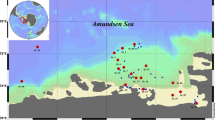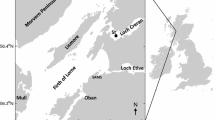Summary
This study of nitrogen metabolism of phytoplankton was one component of a large multidisciplinary program designed to examine the biological productivity of the eastern Scotia Sea, Antarctica, with regard to the importance of the zone of mixing of the northern outflow of the Weddell Sea with Drake Passage waters. The total integrated N-uptake for the euphotic zone in the southwest part of the Scotia Sea was estimated to be in the range of 9.7–14.1 mmol N·m-2·d-1, while for the eastern part of the Scotia Sea it was less than half of this, being 2.1 to 4.7 mmol N·m-2·d-1. The rate of primary production could not be correlated with the front between the two major water masses. Assimilation rates of 15N-enriched substrates indicate that phytoplankton production in the Scotia Sea during austral summer subsists predominantly on ammonia (85%), with lower incorporation rates for nitrate (14%) and nitrite (1%). Nitrate assimilation was much more light-dependent than the uptake of ammonia. These data indicate that there is a rapid and extensive mineralization of organic matter in the surface waters, resulting in a recycling of nitrogen approximately eight times before it is lost from the euphotic zone. This has important implications with regard to the dynamics of the microbial food web in antarctic waters.
Similar content being viewed by others
References
Axler RP, Redfield GW, Goldman CR (1981) The importance of regenerated nitrogen in phytoplankton productivity in a subalpine lake. Ecology 62:345–354
Armstrong FAJ, Stearns CR, Strickland JDH (1967) The measurement of upwelling and subsequent biological processes by means of the Technicon Auto Analyzer and associated equipment. Deep-Sea Res 14:381–389
Biggs DC (1982) Zooplankton excretion and NH +4 cycling in near-surface waters of the Southern Ocean. 1. Ross Sea, Austral Summer in 1977–1978. Polar Biol 1:55–67
BIOMASS Report Series (1981) Post-Fibex Data Interpretation Workshop, Ser No 20
Blackburn TH (1979) Method for measuring rates of NH +4 turnover in anoxic marine sediments using a 15N-NH +4 dilution technique. Appl Environ Microbiol 37:760–765
Bogdanov MA, Oradovskiy SG, Solyankin YV, Khvatskiy NV (1969) On the frontal zone of the Scotia Sea. Oceanology 9:777–783
Booth CR (1976) The design and evaluation of a measurement system for photosynthetically active quantum scalar irradiance. Limnol Oceanogr 21:326–336
Bröckel K Von (1981) The importance of nanoplankton within the pelagic Antarctic ecosystem. Kieler Meeresforsch 5:61–67
Carlberg SR (1972) New Baltic manual. Coop Res Rept ICES, Copenhagen, 145 pp
Carlucci AF, Cuhel RL (1977) Vitamins in the South Polar Seas: distribution and significance of dissolved and particulate vitamin B12, Thiamine, and Biotin in the Southern Indian Ocean. In: Proc 3rd SCAR Symp Antarct Biol, pp 115–128
Conway HL (1977) Interaction of inorganic nitrogen in the uptake and assimilation by marine phytoplankton. Mar Biol 39:221–232
Deacon GER (1937) The hydrology of the Southern Ocean. Discovery Rep 19:1–120
Deacon GER (1977) Seasonal variations in the water temperature and salinity near South Georgia 1925–1937. Inst Oceanogr Sci Rep No 49, 29 pp
Dugdale RC, Goering JJ (1967) Uptake of new and regenerated forms of nitrogen in primary productivity. Limnol Oceanogr 12:196–206
El-Sayed SZ (1968) Primary productivity of the Antarctic and sub-Antarctic. In: Bushnell VC (ed) Primary productivity and benthic marine algae of the Antarctic and sub-Antarctic. Folio Ser, Am Geogr Soc, pp 1–6
El-Sayed SZ, Biggs DC, Stockwell D, Warner R, Meyer M (1978) Biography and metabolism of phytoplankton and zooplankton in the Ross Sea, Antarctica. Antarctic JUS 13:131–133
El-Sayed SZ, Mandelli EF (1965) Primary production and standing crop of phytoplankton in the Weddell Sea and Drake Passage. In: Biology of the Antarctic Seas II, 5, pp 87–106
El-Sayed SZ, Taguchi S (1981) Primary production and standing crop of phytoplankton along the ice-edge in the Weddell Sea. Deep-Sea Res 28:1017–1032
Eppley RW (1972) Temperature and phytoplankton growth in the sea. Fish Bull 70:1063–1085
Eppley RW, Peterson BJ (1979) Particulate organic matter flux and planktonic new production in the deep ocean. Nature 282:677–680
Eppley RW, Renger EH, Venrick EL, Mullin MM (1973) A study of plankton dynamics and nutrient cycling in the central gyre of the North Pacific Ocean. Limnol Oceanogr 18:534–551
Eppley RW, Rogers JN, McCarthy JJ (1969) Half-saturation “constants” for uptake of nitrate and ammonium by marine phytoplankton. Limnol Oceanogr 14:912–920
Eppley RW, Thomas WH (1969) Comparison of half-saturation constants for growth and nitrate uptake of marine phytoplankton. J Phycol 5:375–379
Everson I (1977) The Southern Ocean: The living resources of the Southern Ocean. FAO, Rome, 156 pp
Fay R (1973) Significance of nanoplankton in primary production of the Ross Sea, Antarctica, during the 1972 Austral Summer. PhD Thesis, Texas A & M University, 184 pp
Fiedler R, Proksch G (1975) The determination of nitrogen-15 by emission and mass spectrometry in biochemical analysis. A review. Anal Chim Acta 78:1–62
Fogg GE, Hayes PK (1982) The relative importance of nutrients and hydrographic features for the growth of Antarctic phytoplankton. Joint Oceanographic Assembly, Halifax, Nova Scotia, August 1982, pp 60–61
Gargas E (1975) A manual for phytoplankton primary production studies in the Baltic. The Baltic Marine Biologists, publ. no. 2, available from: Water Quality Institute, 11 Agern Allé, DK-2970 Hörsholm, 88 pp
Glibert PM, Biggs DC, McCarthy JJ (1982) Utilization of ammonium and nitrate during austral summer in the Scotia Sea. Deep-Sea Res 29:837–850
Goldman JC, Carpenter EJ (1974) A kinetic approach to the effect of temperature on algal growth. Limnol Oceanogr 19:756–766
Hardy AC, Gunther ER (1935) The plankton of the South Georgia whaling grounds and adjacent waters, 1926–27. Discovery Rep 11:1–456
Hasle GR (1956) Phytoplankton and hydrography of the Pacific part of the Antarctic Ocean. Nature 177:616–617
Holm-Hansen O (1970) ATP levels in algal cells as influenced by environmental conditions. Plant Cell Physiol 11:689–700
Holm-Hansen O, Booth CR (1966) The measurement of adenosine triphosphate in the ocean and its ecological significance. Limnol Oceanogr 11:510–519
Holm-Hansen O, El-Sayed SZ, Franceschini G, Cuhel R (1977) Primary production and the factors controlling phytoplankton growth in the Southern Ocean. In: Llano GA (ed) Adaptations within Antarctic ecosystem. Proc 3rd SCAR Symp Antarctic Biol, Smithsonian Institition, pp 11–50
Holm-Hansen O, Foster TD (1981) A multidisciplinary study of the eastern Scotia Sea. Antarctic JUS 16:159–160
Holm-Hansen O, Lorenzen CJ, Holmes RW, Strickland JDH (1965) Fluorometric determination of chlorophyll. J. Cons Int Explor Mer 30:3–15
Holm-Hansen O, Riemann B (1978) Chlorophyll a determination: improvements in methodology. Oikos 30:438–447
Horrigan SG (1981) Primary production under the Ross Ice Shelf, Antarctica. Limnol Oceanogr 26:378–382
Karl DM (1980) Cellular nucleotide measurements and applications in microbial ecology. Microbiol Rev 44:739–796
Kiefer DA, Olson RJ, Holm-Hansen O (1976) Another look at the nitrite and chlorophyll maxima in the central North Pacific. Deep-Sea Res 23:1199–1208
Koike I, Rönner U, Holm-Hansen O (1981) Microbial nitrogen metabolism in the Scotia Sea. Antarctic JUS 16:165–166
Koike I, Redalje DG, Ammerman JW, Holm-Hansen O (1983) Highaffinity uptake of an ammonium analogue by two marine microflagellates from the oligotrophic Pacific. Mar Biol 74:161–168
Kristiansen S, Paasche E (1982) Preparation of 15N-labelled phytoplankton samples for optical emission spectrometry. Limnol Oceanogr 27:273–275
Macaulay MC (1981) Distribution and abundance of krill in the Scotia Sea as observed acoustically, 1981. Antarctic JUS 16:166–167
MacIsaac JJ, Dugdale RC (1972) Interactions of light and inorganic nitrogen in controlling N uptake in the sea. Deep-Sea Res 19:209–232
Mackintosh NA (1972) Life cycle of Antarctic krill in relation to ice and water conditions. Discovery Rep 36:1–94
Malone TC (1980) Algal size. In: Morris I (ed) The physiological ecology of phytoplankton. University of California Press, Berkeley pp 433–463
Marr JWS (1962) The natural history and geography of the Antarctic krill (Euphausia superba Dana). Discovery Rep 32:33–464
Neori A, Holm-Hansen O (1982) Effect of temperature on rate of photosynthesis in Antarctic phytoplankton. Polar Biol 1:33–38
Olson RJ (1980) Nitrate and ammonium uptake in Antarctic waters. Limnol Oceanogr 25:1064–1074
Paden CA, Hewes CD, Neori A, Holm-Hansen O, Weaver E, Kiefer DA, Sakshaug E (1981) Phytoplankton studies in the Scotia Sea. Antarctic JUS 16:163–164
Sharp JH (1974) Improved analysis for “particulate” organic carbon and nitrogen from seawater. Limnol Oceanogr 19:984–989
Slawyk G (1979) 13C and 15N uptake by phytoplankton in the Antarctic upwelling area: results from the Antiprod I cruise in the Indian Ocean sector. Aust J Mar Freshwater Res 30:431–448
Smith AE, Morris I (1980) Pathways of carbon assimilation in phytoplankton from the Antarctic Ocean. Limnol Oceanogr 25:865–872
Strickland JD, Parsons TR (1972) A practical handbook of seawater analysis, 2nd edn. Bull Fish Res Bd Can, 167 pp
Sverdrup HM (1953) On conditions for the vernal blooming of phytoplankton. J Cons Int Explor Mer 18:287–295
Author information
Authors and Affiliations
Rights and permissions
About this article
Cite this article
Rönner, U., Sörensson, F. & Holm-Hansen, O. Nitrogen assimilation by phytoplankton in the Scotia Sea. Polar Biol 2, 137–147 (1983). https://doi.org/10.1007/BF00448963
Received:
Accepted:
Issue Date:
DOI: https://doi.org/10.1007/BF00448963




